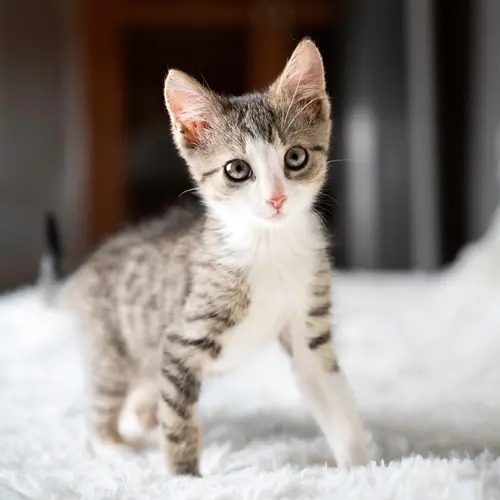Cory catfish is a popular tropical fish for freshwater aquariums. They live in the wild throughout South America including in the Amazon. There are over 150 different species of Corydoras — the scientific name for the cory catfish.
Cory Catfish Characteristics
Cory catfish are known as armored catfish because they have two rows of overlapping bony plates, called scutes, that run from the back of their head to the base of their tail. Scientists who tested these scutes — by trying to pierce them with needles — were surprised at how much force they could stand up to. The scutes protect the cory catfish but still allow the fish the flexibility to swim easily.
Cory catfish have stiff spines at the beginning of their dorsal, or back, and pectoral, or chest, fins. In some species, these spines have venom glands. When the spine pierces an enemy — usually another animal trying to eat the catfish — the venom enters the enemy’s puncture wound, causing pain, swelling, and muscle spasms.
Cory Catfish Size
Cory catfish species vary in size, but none grow very large. They range from 2.5 to 12 centimeters in total length — that’s a little less than an inch to about 4.75 inches. Most cory catfish are less than 7 centimeters — or about 2.75 inches — in length.
Cory Catfish Behavior
Cory catfish are a little different from most fish because they can breathe air. They dash from the bottom of the aquarium up to the surface to take a gulp of air. They swallow the air as a bubble and then their intestines get the oxygen out of the air. The fish releases any extra air through their vent — an opening near their tail from where they expel waste.
Cory catfish can also get oxygen from the water through their gills. Another reason they swallow air is to help keep them down under the water.
In the wild, going up to the surface to get air increases the risk of being eaten by a predator. Some cory catfish species will lessen this risk for each individual fish by breathing air as a group. They’ll all swim to the surface together to gulp air to reduce the chance of one of them becoming a meal for another animal.
Cory catfish also spawn, or lay eggs, in groups. For each pair in the group, as a male fish fertilizes the female’s eggs, she cups the eggs in her pelvic fins on her underside using the fins — this sort-of basket helps her carry the eggs. Then, she swims down and pastes the sticky fertilized eggs, one at a time, on rocks and plants on the bottom. Mating pairs keep doing this over and over for hours until they have spawned hundreds of eggs.
After the group has spawned their eggs, the male and female fishes swim away. They don’t protect their eggs or provide any other parental care.
Cory Catfish Temperature
The water temperature your cory catfish needs will depend on which type of cory you have. Spotted corydoras like water at 21 to 24 degree Celsius, while bronze corydoras like the water a little bit warmer at 25 to 28 degree Celsius. The temperature requirements of most cory catfish, being tropical fish, fall somewhere in the range of 21 to 28 degree Celsius — that’s 70 to 82 degrees Fahrenheit.
Cory Catfish Care
The pH requirements of cory catfish vary somewhat, but most species can tolerate a pH between 6.0 and 8.0.
In the wild, cory catfish swim in shoals or groups. These social fish will do best if you have at least five of them in your aquarium. They'll have enough room to swim in a fish tank that is at least 60 centimeters or about 24 inches long.
Cory catfish are bottom dwellers. Choose food for them that will sink to the bottom of the tank. If you have other types of fish in the same aquarium, watch to make sure that these other fish aren’t eating all the food before it gets to your bottom dwellers. Cory catfish typically ignore food floating in the water or on the surface.
Cory catfish have a small mouth on the underside of their head that makes it easy for them to eat food from the bottom of the aquarium. They also have barbels — which are fleshy extensions around their mouths that they use to search for food in the sand or pebbles. Some fish use their barbels to taste and smell, but catfish barbels can’t do either.
The diet of a cory catfish in the wild includes insects, worms, crustaceans, and plant matter like decaying leaves from aquatic plants. Besides sinking pellets and algae wafers, cory catfish in an aquarium enjoy live foods such as brine shrimp, bloodworms, and daphnia.
Cory Catfish Diseases
Ich. This disease is caused by a parasite and can quickly kill many fish. The classic symptom of ich is tiny white specks on the skin of an infected fish, so it is sometimes called white spot disease. To prevent ich from infecting all your fish, keep new fish in a separate aquarium for a week to watch them for signs of disease before putting them in your main aquarium.
There are medicines to treat the whole aquarium for ich. You usually have to repeat the treatment several times on different days to clear the tank of ich.
Red spot disease. In this disease, also called epizootic ulcerative syndrome (EUS), a fungus causes red sores on the fish's skin. Red spot disease often kills fish and easily spreads from one fish to another.
Fin rot. Bacteria damage the fish’s fins, making them look ragged.
Nitrate poisoning. Cory catfish can get sick if the nitrate levels in your aquarium get too high. Fish with nitrate poisoning may stop eating, breathe faster than normal, and lie on the bottom of the tank.
